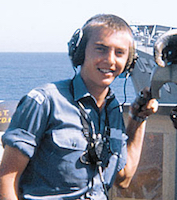Ordinary Seaman Raymond John Butterworth

Raymond John Butterworth was born in London, England on 4 August 1949. He joined the Royal Australian Navy from Risdon Vale, Tasmania, as a general entry sailor on 30 June 1967 undertaking his basic training at HMAS Cerberus.
In September 1967 he completed category training as an Ordinary Seaman Quartermaster Gunner and was subsequently posted to the guided missile destroyer HMAS Hobart in which he deployed to Vietnam during her second tour of duty in March 1968.
In the early hours of 17 June 1968 Hobart was part of a naval task unit operating in the vicinity of Tiger Island north of the demilitarized zone off the east coast of North Vietnam. An unidentified aircraft was detected approaching the ship from the vicinity of Cap Lay and although evaluated as a ‘friendly’ it continued to close, firing a missile that struck Hobart amidships on her starboard side. The warhead passed through the main deck, seriously damaging several compartments, while the body of the missile passed through the outer skin of the aft funnel before ending up embedding itself in the forward funnel. In its passage shrapnel from the disintegrating missile killed Ordinary Seaman Butterworth who was closed up as a lookout on the port side, at the aft end of the flagdeck above the bridge. Able Seaman JR Parker and Ordinary Seaman RF Davidson also suffered injuries.
As Hobart's crew raced to action stations a second and third missile hit the ship. The second missile entered the transom without detonating, destroying the gunner's store before breaking up in the engineer's workshop and penetrating the after seaman's mess. The third missile hit the ship in the same area as the first, passing through one of the ship's fan spaces, the missile director equipment room and Tartar checkout room. Chief Electrician RH Hunt was killed in this attack and several sailors injured.
The aircraft was seen to pass over the ship before turning again for what appeared to be a further attack run. At 8000 yards the crew of Hobart's forward gun engaged the aggressor, firing five rounds in local control, causing it to turn away before being lost to radar south of Tiger Island. As Hobart's damage control parties made their assessment USS Edson, which was operating in company with Hobart, reported that she too was coming under fire from air launched missiles. The force consequently cleared the area to the west with Hobart departing the operational area to effect repairs in Subic Bay, Philippines.
En route the ship's company began clearing away debris, finding and collecting pieces of the missiles which were later identified as being of US origin. It transpired that Hobart was one of several ships mistakenly attacked by US 7th Air Force jets on the nights of 16-17 June. Hobart subsequently arrived in Subic Bay on 19 June where her damaged was assessed. The destroyer had suffered serious damage to her weapons systems, electrical systems and hull. The Ikara missile magazine had also suffered heavy damage in the attack and it proved fortunate that it was empty at the time of the attack.
Ordinary Seaman Butterworth was buried at Cornelian Bay Public Cemetery, Hobart, Tasmania, and is memorialised on Panel 4 in the commemorative area of the Australian War Memorial in Canberra.


